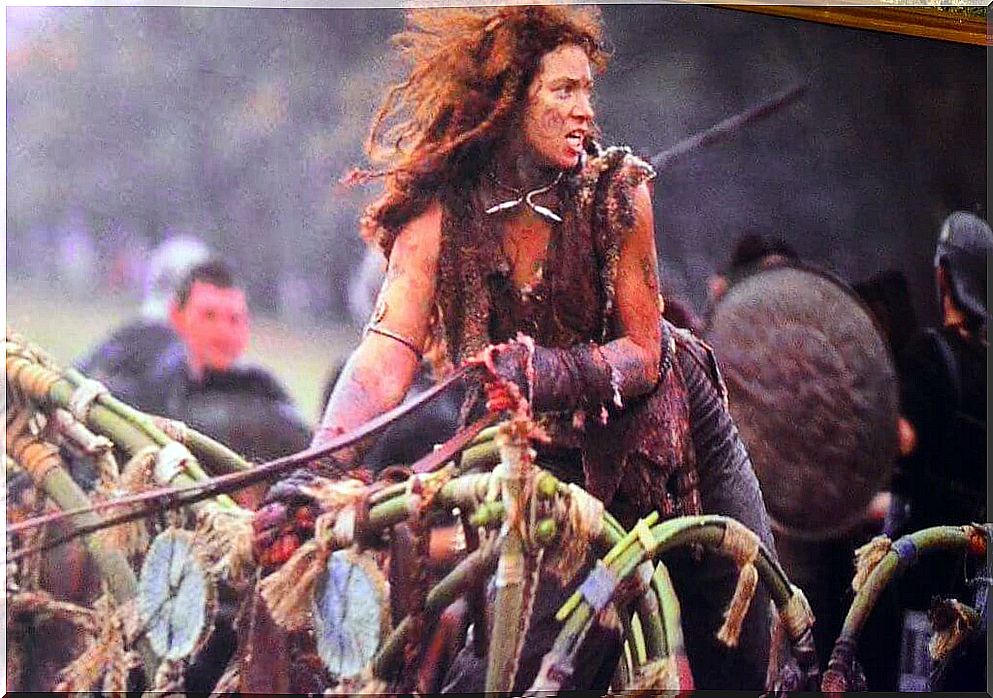Boudica: The Biography Of A Warrior Queen

Boudica is a fascinating historical figure who, over time, was elevated as a very powerful archetype. Queen of the Icenos and leader of the Resistance in Anglia, Boudica led a massive army against the Roman legions to free Britannia from the Empire.
For centuries, it was the symbol of the struggle against the injustice exerted by patriarchal Rome on the feminine values of pre-Roman Europe. Boudica personifies all the qualities that the Roman patriarchy would not allow in women and which he ended up nullifying by force.
This Celtic queen was a free woman, fierce and wild. She prayed to the pagan gods and was the leader of a huge army of blue-painted savages that followed her to her death. Many of the classic female warriors are presented as young virgins, but that is not the case with Boudica. She had several daughters who fought with her against the Roman invasion and in defense of her people, her men, her women, her culture and her religion. She became the archetype of the avenging woman and mother, who brings fire and blood to those who harm her.
Unlike Joan of Arc and other later heroines, Boudica never renounced her womanhood, adopted masculine mores, or hid her feminine nature behind the mists of mysticism.
Boudica was a woman, from head to toe, who would never renounce any of her aspects as a person. Not even what was seen as a symbol of femininity: motherhood. This was how the Celts understood the nature of woman, as that of an equal with her own characteristics. An idea far removed from the Roman patriarchal vision of female roles.

Boudica’s encounter with the Romans
Boudica was born around AD 30, during the term of Emperor Claudius, when the Roman invasion had already established many outposts in the British Isles. Daughter of a probably noble family, she stood out from childhood for her intelligence, athletic build and beauty. At age 18, he married Prasutagus, king of the Icenos, one of the Celtic tribes that settled in the eastern part of the islands.
The Icenos enjoyed considerable independence from the Romans, thanks to agreements reached with the emperor that involved a considerable payment of taxes. The Celtic peoples were of Druidic tradition, they sought harmony between humans and nature, astrology and magic. They were brave warriors who believed in reincarnation, were not afraid of death and were fearless in battle. They pitted their bodies in blue and fought practically naked. The magic applied to battles and their fierce appearance terrified the Roman legions.
Boudica had two daughters by the king and was queen consort. The Celts considered women their equals, and they could hold political and religious positions. Prasutagus knew that this aspect was not the same for the Romans, heirs to the Greek cultures of the masculine. In an attempt to protect his family and people, he made a deal with Roman procurator Cathus, in which he would cede half of his fortune and kingdom to the Roman Empire, leaving the other half to his daughters and his wife, who would occupy the position of queen of the Icenos when he died.
an unfulfilled agreement
Boudica’s husband died shortly after making such an agreement, and at about the same time Emperor Claudius also died. His heir, Nero, did not respect any of the agreements with the Celtic tribe. The new emperor did not recognize Boudica as queen of the Icenos, nor her daughters as heirs. He was unwilling to acknowledge the power of any Celtic woman.
In a grotesque display of power, the Roman procurator attacked the Icena tribe, turning many nobles into slaves and appropriating all the possessions of Boudica and her people. In a fit of total contempt for the Celtic queen, he ordered her to be publicly flogged while forcing her to watch the horrific scene of her daughters being raped by every Roman centurion under her command.
Through rape, the Romans were evidencing their principles, their imposition of power by force, flaunting their masculinity and emphasizing their supposed superiority. It is at this point that Boudica gathers several Celtic tribes, organizes them under his command and prepares them to attack the Roman invaders. Some sources estimate that she had about 230,000 warriors under her command.
Boudica and his army’s attack
The Icenos, under the command of Boudica, decide to attack Camuloduno, the village where Cathus resided. The Roman procurator had called for reinforcements in the face of the imminent attack by the mighty British resistance army, but it was of little use. Boudica and his men annihilated the reinforcements sent from Londinium, as well as the 2,500 centurions of the IX Legion sent from Hispania before reaching Camulodunus . Once there, they executed Cathus and massacred the city, as the Celts, unlike the Romans, had no prisoners.
Boudica immediately takes her army to Londinium, willing to do the same to him. Suetonius, the Roman general and new governor of Britannia, decides that Londinium is indefensible and leaves the city along with his army and the Roman nobles who managed to flee.
When Boudica and her army arrive, Londinium is left to its own devices and defenseless. The Celts take the city and, without rest, head quickly to Verulamius, where they win again. Within weeks, the army led by Boudica is estimated to have taken over the three main Roman settlements in Britannia.

Under the feet of the patriarchal machine
Suetonius, who openly admired and respected Boudica and deeply hated Nero, was forced to assemble an army capable of facing off in numbers the men and women of Boudica. After an epic and bloody battle, the Roman legions subdued the Celtic army.
Some authors say that Boudica died in battle, but it is not known for sure. She was honored with funerals as Queen of Britannia and her remains were hidden forever. His life has been transformed into a powerful legacy that functions as an archetype and represents rebellion against submission.
Boudica and the men and women of the Iceno army knew they would die during the last battle against the Romans. But they also firmly believed in reincarnation and therefore that this battle would not lead to the end of their existence. They might have to wait a few more centuries, but eventually they would come back to life to fight again, and this time they would win forever.
The story of Boudica is the story of many other men and women from the tribes of Atlantic Europe who fought against the invaders of the Roman Empire, an empire based on patriarchy. The tribes only wanted to defend what rightfully belonged to them, they fought in defense of their lands, their culture and their traditions in Britannia, Gaul and Iberia. In short, a struggle for identity and against submission.
Boudica’s story, which oscillates between the historical and the legendary, shows us that, in the past, there were also courageous women and mothers who managed to demonstrate their talent beyond the domestic sphere. Boudica is the name of a woman who stands out among the infinite male names that write our history, a symbol of struggle and courage.









